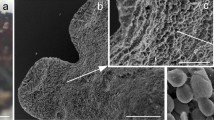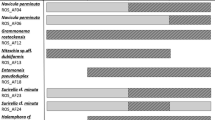Abstract
We explored a benthic community living on stones in an acidic (pH≤2) stream of active volcanic origin from Patagonia, Argentina, by combining in situ measurements (temperature, pH, conductivity, dissolved oxygen), photosynthesis of intact biofilms (measured with microsensors by the light–dark shift method), pure-culture experiments on isolated algae, and confocal laser scanning microscopy on the biofilms. The epilithon of the Agrio River was dominated (99% of total biomass) by one species: Gloeochrysis (Chrysophyceae). This species was observed as brown, mucilaginous, 200-μm-thick films on stones, growing in clumps in a dense matrix of fungal hyphae, bacteria, and inorganic particles held together by extracellular polymeric substances. Gloeochrysis was isolated and cultivated. The photosynthetic rate measured at saturation irradiance was 120 μmol oxygen (mg chlorophyll a)−1h−1 under laboratory conditions, and the saturation rate of photosynthesis by carbon dioxide was 90 μmol oxygen (mg chlorophyll a)−1 h−1 for oxygen evolution. Photosynthetic activity of the biofilm was light-dependent and saturated above 200 μmol photons m−2 s−1. In the dark, the stone surface became anoxic. Our data suggest that primary production in the Agrio River was not limited by light, carbon, or phosphorus but instead, nitrogen-limited.







Similar content being viewed by others
References
APHA (1992) Standard methods for the examination of water and wastewater, 18th edn. American Public Health Association, Washington
Beamud SG (2001) Influencia de los aportes de nutrientes sobre la calidad del agua de un lago ácido: Lago Caviahue. Dissertation, Universidad del Comahue
Booth B (1993) Estimating cell concentration and biomass of autotrophic plankton using microscopy. In: Kemp P, Sherr B, Sherr E, Cole JJ (eds) Handbook of methods in aquatic microbial ecology. CRC Press, Boca Raton
Delmelle P, Bernard A (2000) Volcanic lakes. In: Sigurdsson H, Houghton B, McNutt S, Rymer H, Stix J (eds) Encyclopedia of volcanoes. Academic Press, San Diego, pp 877–895
DeNicola D (2000) A review of diatoms found in highly acidic environments. Hydrobiologia 433:111–122
Geitler L (1967) Gloechrysis apyrenigera n. sp. und der Chromatophor von Phaeodermatium. Österr Botan Z 114:115–118
Geller W, Klapper H, Schultze M (1998) Natural and anthropogenic sulphuric acidification of lakes. In: Geller W, Klapper H, Salomons W (eds) Acidic mining lakes: acid mine drainage, limnology and reclamation. Springer, Berlin Heidelberg New York, pp 3–14
Glud RN, Ramsing NB, Revsbech NP (1992) Photosynthesis and photosynthesis-coupled respiration in natural biofilms quantified with oxygen microsensors. J Phycol 28:51–60
Gross W (2000) Ecophysiology of algae living in highly acidic environments. Hydrobiologia 433:31–37
Haack TK, McFeters GA (1982) Microbial dynamics of an epilithic community in a high alpine stream. Appl Environ Microbiol 43:702–707
Hutchinson GE (1957) A treatise on Limnology. Wiley, New York
Jørgensen BB, Revsbech NP (1985) Diffusive boundary layers and the oxygen uptake of sediments and detritus. Limnol Oceanogr 30:111–122
Kalina T (1969) Gloeochrysis montana n. sp. und Poterioochromonas stipitata Scherffel (Chrysophyceae) aus Krkonoše (Riesengebirge). Österr Bot Z 117:139–145
Lackey JB (1939) Aquatic life in waters polluted by acid mine waste. Public Health Rep 54:740–746
Lerman A (1988) Geochemical processes, water and sediment environment. RE Krieger, Malabar
Lessmann D, Deneke R, Ender R, Hemm M, Kapfer M, Krumbeck H, Wollmann K, Nixdorf B (1999) Lake Plessa 107 (Lusatia, Germany)—an extremely acidic shallow mining lake. Hydrobiologia 408–409:293–299
Maberly SC, King L, Dent MM, Jones RI, Gibson CE (2002) Nutrient limitation of phytoplankton and periphyton growth in upland lakes. Freshwater Biol 47:2136–2152
Markert B, Pedrozo F, Geller W, Friese K, Korhammer S, Baffico G, Diaz M, Wölfl S (1997) A contribution to the study of the heavy-metal and nutritional element status of some lakes in the southern Andes of Patagonia (Argentina). Sci Total Environ 206:1–15
Nakatsu C, Hutchinson T (1988) Extreme metal and acid tolerance of Euglena mutabilis and an associated yeast from Smoking Hills, Northwest Territories, and their apparent mutualism. Microb Ecol 16:213–231
Neu TR, Lawrence JR (1999) Lectin-binding analysis in biofilm systems. In: Doyle RJ (ed) Biofilms. Methods in Enzymology. Academic Press, San Diego, pp 145–152
Nixdorf B, Kapfer M (1998) Stimulation of phototrophic pelagic and benthic metabolism close sediments in acidic mining lakes. Water Air Soil Pollut 108:317–330
Nixdorf B, Mischke U, Lessmann D (1998) Chrysophytes and chlamydomonads: pioneer colonists in extremely acidic mining lakes (pH<3) in Lusatia (Germany). Hydrobiologia 369–370:315–327
Niyogi D, McKnight D, Lewis W (1999) Influences of water and substrate quality for periphyton in a montane stream affected by acid mine drainage. Limnol Oceanogr 44:804–809
Ohle W (1981) Photosynthesis and chemistry of an extremely acidic bathing pond in Germany. Verh Int Verein Limnol 21:1172–1177
Pascher A (1925) Die braune Algenreihe der Chrysophyceen. Arch Protistenkd 52:489–564
Pascher A (1931) Eine braune, aërophile Gallertalge und ihre Einrichtungen für die Verbreitung durch den Wind. Beih Bot Centralbl 47:325–345
Pedrozo F, Kelly L, Diaz M, Temporetti P, Baffico G, Kringel R, Friese K, Mages M, Geller W, Woelfl S (2001) First results on the water chemistry, algae and trophic status of an Andean acidic lake system of volcanic origin in Patagonia (Lake Caviahue). Hydrobiologia 452:129–137
Pedrozo F, Geller W, Beamud G, Woelfl S, Diaz M, Whitton B, Wenzel MT, Kringel R, Schimmele M, Baffico G, Temporetti P, Mages M (2002) The acidic waters of the crater Copahue—Agrio River—Lake Caviahue system (Patagonia, Argentina). Verh Int Verein Limnol 28:112–113
Planas D, Lapierre L, Moreau G, Allard M (1989) Structural organization and species composition of a lotic periphyton community in response to experimental acidification. Can J Fish Aquat Sci 46:827–835
Revsbech NP, Jørgensen BB (1983) Photosynthesis of benthic microflora measured with high spatial resolution by the oxygen microprofile method: capabilities and limitations of the method. Limnol Oceanogr 28:749–756
Revsbech NP, Jørgensen BB (1986) Microelectrodes: their use in microbial ecology. Adv Microbiol Ecol 9: 293–351
Revsbech NP, Jørgensen BB, Brix O (1981) Primary production of microalgae in sediments measured by oxygen microprofile, H14CO −3 fixation, and oxygen exchange method. Limnol Oceanogr 24:717–730
Rudd J, Kelly C, Schindler D, Turner M (1988) Disruption of the nitrogen cycle in acidified lakes. Science 240:1515–1517
Satake K, Saijo Y (1974) Carbon dioxide content and metabolic activity of microorganisms in some acid lakes in Japan. Limnol Oceanogr 19:331–338
Satake K, Oyagi A, Iwao Y (1995) Natural acidification of lakes and rivers in Japan: the ecosystem of Lake Usoriko (pH 3.4–3.8). Water Air Soil Pollut 85:511–516
Schimmele M, Herzsprung P (2000) Limnology of sulphur acidic lignite mining lakes. I. Physical properties: influence of dissolved substances on electrical conductivity and the density structure. Verh Int Verein Limnol 27:251–255
Schindler D (1985) The coupling of elemental cycles by organisms: evidence from whole-lake chemical perturbations. In: Stumm W (ed) Chemical processes in lakes. Wiley, New York, pp 225–250
Schindler D, Holmgren S (1971) Primary production and phytoplankton in the Experimental Lakes Area, Northwestern Ontario, and other low carbonate waters, and a liquid scintillation methods for determining C14 activity in photosynthesis. J Fish Res Board Can 28:189–201
Schwenke H, Beaven PA, Knoth J (1999) Applications of total reflection X-ray fluorescence spectrometry in trace element and surface analysis. Fresenius J Anal Chem 365:19–27
Sheath R, Havas M, Hellebust J, Hutchinson T (1982) Effects of long-term natural acidification on the algal communities of tundra ponds at the Smoking Hills, NWT, Canada. Can J Bot 60:58–72
Snoeijs P, Snoeijs F (1993) A simple sampling device for taking quantitative microalgal samples from stone surfaces. Arch Hydrobiol 129:121–126
Stumm W (1985) Chemical processes in lakes. Wiley, New York
Stumm W, Schnoor J (1995) Atmospheric depositions: impact of acids on lakes. In: Lerman A, Imboden D, Gat J (eds) Physics and chemistry of lakes. Springer, Berlin Heidelberg New York, pp 185–215
Turner M, Jackson M, Findlay D, Graham R, DeBruyn E, Vandermeer E (1987) Early responses of periphyton to experimental lake acidification. Can J Fish Aquat Sci 44:135–149
Turner M, Howell E, Summerby M, Hesslein R, Findlay D, Jackson M (1991) Changes in epilithon and epiphyton associated with experimental acidification of a lake to pH 5. Limnol Oceanogr 36:1390–1405
Wendt-Potthoff K, Koschorreck M (2002) Functional groups and activities of bacteria in a highly acidic volcanic mountain stream and lake in Patagonia, Argentina. Microb Ecol 43:92–106
Wetzel R, Likens G (1991) Limnological analysis, 2nd edn. Springer, Berlin Heidelberg New York
Whitton B, Diaz B (1981) Influence of environmental factors on photosynthetic species composition in highly acidic waters. Verh Int Verein Limnol 21:1459–1465
Acknowledgements
The authors wish to thank Margarete Mages for performing the elemental analyses, Alberto Taiano for field assistance, and Ute Kuhlicke for help with the CLSM. Thanks to Dr. Elanor Bell for improving the manuscript. Many thanks to Dr. Stephen Maberly (Centre for Ecology and Hydrology, Windermere, UK) for setting up and helping in the photosynthesis experiments. This study was supported by grants from Fundación Antorchas, Universidad Nacional del Comahue (04 B920), the International Bureau of Germany, and ANPCyT PICT 01-08186.
Author information
Authors and Affiliations
Corresponding author
Additional information
Communicated by W.D. Grant
Rights and permissions
About this article
Cite this article
Baffico, G.D., Diaz, M.M., Wenzel, M.T. et al. Community structure and photosynthetic activity of epilithon from a highly acidic (pH≤2) mountain stream in Patagonia, Argentina. Extremophiles 8, 463–473 (2004). https://doi.org/10.1007/s00792-004-0408-1
Received:
Accepted:
Published:
Issue Date:
DOI: https://doi.org/10.1007/s00792-004-0408-1




